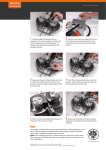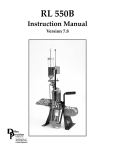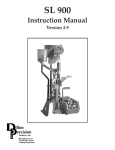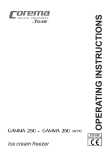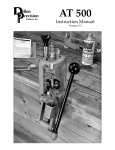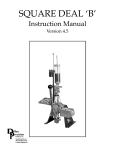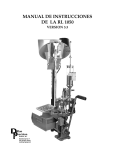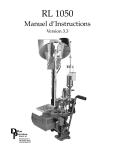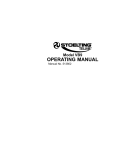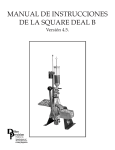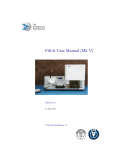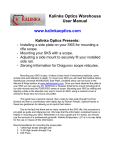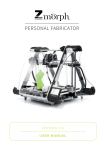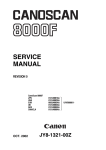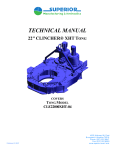Download RL 1050
Transcript
RL 1050 Instruction Manual Version 3.3 illon recision Products, Inc. Manufacturers of The World's Finest Loading Equipment On the cover… The RL 1050 is pictured with optional accessories: Powdercheck System #21044 Low Powder Sensor #16306 Bullet Tray #22215 Other accessories available for the RL 1050 include: Machine Cover #13239 Maintenance Kit & Spare Parts Kit #97018 The Blue Press, Dillon’s monthly catalog, has a complete listing of accessories available for all machines. #13385 Spot Manuals RL1050 Man Folder RL1050 Manual V3.3 9/01 WJC Table of Contents Warranty Agreement 4 Mandatory Safety Measures 4 RL1050 Assembly 5 Powder Measure Adjustment 8 Primer Magazine 9 Electric Casefeeder 10 How the RL1050 Works – Stations 1 - 8 10 To Begin Reloading 11 Adjustments and Conversions: 11 Casefeeder 11 Handle 12 Swager 12 Swage Conversion & Adjustment 12 Primer System Change Over Instructions 12 Toolhead Removal 13 Shellplate Removal 14 Casefeed Plunger Conversion 14 Die Adjustments 14 Older Model Users 15 Trouble Shooting 16 Maintenance 17 Definitions 17 Caliber Conversion Chart 19 Parts List 20 Schematics 21 - 25 Dillon Precision Products, Inc. 8009 E. Dillon’s Way Scottsdale, AZ 85260 (480) 948-8009 FAX (480) 998-2786 Web Site: www.dillonprecision.com E-mail: [email protected] Technical Support & Customer Service (800) 223-4570 Warranty Agreement Never operate the machine without ear and eye protection on. Call our customer service department at (800) 223-4570 for information on the wide variety of shooting/safety glasses and hearing protection that Dillon has to offer. • PAY ATTENTION: Load only when you can give your complete attention to the loading process. Don’t watch television or try to carry on a conversation and load at the same time. Watch the automatic systems operate and make sure they are functioning properly. If you are interrupted or must leave and come back to your loading, always inspect the cases at every station to insure that the proper operations have been accomplished. • SMOKING: Do not smoke while reloading or allow anyone else to smoke in your reloading area. Do not allow open flames in reloading area. • SAFETY DEVICES: Do not remove any safety devices from your machine or modify your machine in any way. • LEAD WARNING: Be sure to have proper ventilation while handling lead components or when shooting lead bullets. Lead is known to cause birth defects, other reproductive harm and cancer. Wash your hands thoroughly after handling anything made of lead. • LOADS AND LENGTHS: Avoid maximum loads and pressures at all times. Use only recommended loads from manuals and information supplied by reliable component manufacturers and suppliers. Since Dillon Precision has no control over the components which may be used on their equipment, no responsibility is implied or assumed for results obtained through the use of any such components. The Dillon RL1050 reloader has been designed as a commercial machine. Our expectation is that its life expectancy will be in excess of two million rounds of loaded ammunition. All RL1050 machines are warranted for life from defects in material or workmanship, plus a one year 100% warranty against normal wear. All electrical/electronic components in Dillon equipment are covered by a one year warranty. However, the RL1050 is a complex machine and we need your cooperation. So there’s a hitch. All we ask is that you take the time to read the following information and fill out the warranty registration card stating that you have done so. Mandatory Safety Measures The reloading of ammunition and the handling of components (gun powder and primers) is inherently dangerous, indeed shooting firearms is inherently dangerous. Accidents can and do occur, sometimes with disastrous results including, but not limited to, loss of vision, hearing or life. These accidents are nondiscriminatory, they occur with both the novice and the experienced reloader. Dillon Precision Products has consciously designed the RL1050 with this in mind. We’ve shielded the primer magazine and machined clearance holes for the elimination of powder and primer residue. In short, we have done everything we know how, to make the use of our machine as safe as possible. We cannot however, guarantee your complete safety. In order to minimize your risk, use common sense when reloading and follow these basic rules: 4 Seat bullets as close to maximum cartridge length as possible. Under some conditions, seating bullets excessively deep can raise pressures to unsafe levels. Refer to a reliable loading manual for overall length (OAL). • QUALITY CHECKS: Every 50-100 rounds, perform periodic quality control checks on the ammunition being produced. Check the amount of powder being dropped and primer supply. • RELOADING AREA: Keep your components safely stored. Clear your work area of loose powder, primers and other flammables before loading. • COMPONENTS: Never have more than one type of powder in your reloading area at a time. The risk of a mix-up is too great. Keep powder containers closed. Be sure to inspect brass prior to reloading for flaws, cracks, splits or defects. Throw these cases away. Keep components and ammunition out of reach of children. • BLACK POWDER: Do not use black powder or black powder substitutes in any Dillon powder measure. Loading black powder cartridges requires specialized loading equipment and techniques. Failure to do so can result in severe injury or death. • PRIMERS: Never force primers. If they get stuck in the operation of the machine, disassemble it and gently remove the obstruction. Never attempt to clear primers that are stuck in either the primer pickup tube or the primer magazine tube. Never, under any circumstances, insert any type of rod to attempt to force stuck primers out of these tubes. Trying to force primers out of the tube will cause the primers to explode causing serious injury or even death. If primers get stuck in a primer magazine or pickup tube flood the tube with a penetrating oil (WD-40), throw the tube in the garbage and call us for a free replacement. Never attempt to deprime live primers – eventually one will go off. When it does it will detonate the others in the spent primer cup. Depriming live primers is the single most dangerous thing you can do in reloading and can cause grave injury or death. • LOADED AMMUNITION: Properly label all of your loaded ammunition (Date, Type of Bullet, Primer, Powder, Powder Charge, etc.). • BE PATIENT: Our loading equipment is conservatively rated and you should have no trouble achieving the published rates with a smooth, steady hand. If something doesn’t seem right, stop, look and listen. If the problem or the solution isn’t obvious, call us. The reloading bench is no place to get into a hurry. We have done everything we know how to make your machine as safe as possible. We cannot, however, guarantee your complete safety. To minimize your risk, use common sense when reloading and follow these basic rules. • REMEMBER: If your machine does not perform to your expectations, or if you are having technical difficulties, give us a call. Technical Support (800) 2234570. How the RL1050 Works Stations 1 - 8 (counterclockwise) Station 1: In this station the empty cases are automatically inserted into the shellplate via the electric casefeeder. Station 2: Here the spent cartridge cases are resized and deprimed. Station 3: This station is totally unique. The case is supported from the inside and slightly expanded (not belled) while simultaneously a swager is driven into the primer pocket to remove any crimp. Station 4: In this station a new primer is installed. The spring driven primer slide is extremely smooth. The steel shrouded primer magazine is capped with an electronic Early Warning Device to let you know when you’re down to approximately three primers. Station 5: Here the case is belled and powder is dropped by the case activated powder measure. It is extremely accurate and will not drop powder unless a case is present. Dillon Precision offers an optional accessory to be utilized with the automatic powder measure at this station – Dillon’s Low Powder Sensor provides an audible and visual reminder when it’s time to refill the powder reservoir. Station 6: This station is open to allow for case inspection. Station 7: In this station the bullet is seated to its proper depth. Station 8: In this station the bullet is crimped into place. The cartridge is then automatically ejected into a collection bin. Your dies have been adjusted at the factory. Before you change anything, try it the way it is, once you thoroughly understand the machine’s operation, make whatever adjustments to the dies you feel necessary. Reminder: There may be some variation due to components. RL1050 Assembly Your new RL1050 has been assembled at the factory. All of the adjustments necessary to reload have already been made, in fact we’ve even adjusted the dies to reload the caliber you have chosen. However, before you can reload you must do some minor assembly. Due to variations in components, check all stations for proper settings before loading ammunition. It is absolutely necessary that you read the following instructions. 5 * Indicates a caliber specific part – see the caliber conversion chart on page 19 for the caliber you are loading for. If you get stuck on something that you don’t understand, call (800) 223-4570 for technical assistance. Step 1: Mounting the RL1050 Select a clear area on your reloading bench. Be certain your bench is free from vibration and is strong enough to support your RL1050’s mass and operating force. If possible attach your bench to the wall using screws. Fig. 2: Locator button being inserted into its proper position. Install the six brass locator buttons (#20637*) around the shellplate (#12600*). Fig. 2 Fig. 1: Be sure the machine is to the forward edge of the table or bench when marking the four holes to be drilled. Remove the RL1050 main frame from the packaging and place it on your selected area. The crank extension (#12901) should be to your right. Bring the machine to the forward edge of your bench – be sure to allow clearance for operation of the handle. Mark the four mounting holes using the machine as a template. Remove the machine and drill four 1/4” holes through the bench. Replace the machine and bolt securely. Fig. 1 Install the handle (#12727) as indicated in the parts schematic. Secure in place with the handle set screw (#13432). You will note that there are three different positions for mounting the operating handle. Choose the one that feels best for you. The longer the handle is, the less force is required but the stroke is longer. The toolhead (#20420) is held down on the main frame for shipping by the use of plastic ties. Remove the ties while holding the handle. Slowly move the handle up. This will move the toolhead approximately three inches to its “up” position. Note: If the handle is not moving freely, carefully inspect for shipping damage. Fig. 3: Place an Allen wrench into the cross hole and use it for leverage to tighten the casefeed post studs. Step 2: Installing the Casefeed Assembly Using the screw provided (#13377) install the cartridge bin bracket (#13238) to the main frame. Fig. 3 Screw the casefeed post studs (#13271) to the main frame (place the washer provided on the bottom post only), tighten securely with an Allen wrench through the cross hole provided. Fig. 3 Install the bullet bin bracket (#12144) to the casefeed post (#20641) using the screw (#13685). See the schematic on page 24. The casefeed mounting post assembly (#20641) is attached to the casefeed post studs (#13271) by the use of two post bolts (#13205). Attach the power cable and clamp as shown in the schematic on page 24. 6 * Indicates a caliber specific part – see the caliber conversion chart on page 19 for the caliber you are loading for. The casefeed bowl assembly needs to be placed on the casefeed post with the Dillon logo and the on/off switch facing you. Fig. 6: See arrow. A slight gap allows the powder die to be adjusted without removing the powder measure. Fig. 4: The proper location and positioning of the casefeed tube and adapter is as shown above. Clip Fig. 5: The end of the casefeed tube marked “up” snaps into the clip at the base of the casefeeder motor housing. Spring The casefeed tube (#13761) should now be inserted into the casefeed adapter (#13654*) Fig. 4 Note that the tube is marked “up” on one end. Press this end into the tube clip (#13859) attached to the casefeeder motor housing Fig. 5. This assembly is now complete. Fig. 7: Note how the spring above the wingnut is slightly compressed. Step 3: Installing the Powder Measure Remove the blue cap from the powder die (#20320) and loosely clamp the powder measure in position. Fig. 6 Install the powder measure return rod (#13960) through the 3/8” eyebolt (#13089) mounted on the left rear of the main frame. Fig. 7 Now attach the rod to the powder measure bellcrank using the clip. Fig. 7 Install 7 * Indicates a caliber specific part – see the caliber conversion chart on page 19 for the caliber you are loading for. the spring (#14033) and wing nut (#13799) on the rod and screw the wing nut up until you feel light tension on the spring. Tighten the powder measure clamp screws (#14037). Fig. 9: This photo shows the powder bar at the end of its travel. It is important to understand that the adjustable powder bar should reach the end of its travel at the same time that the handle reaches the bottom of its stroke against the frame stop. Fig. 9 To achieve this adjustment, the die body must be screwed up or down as needed. The powder die has already been adjusted at the factory. An empty case must be placed in the shellplate at Station 5 in order to check this adjustment. Note that the case used to adjust the powder measure die must already be sized. NOTE: If you are adjusting for a straight wall case, start your powder die adjustment with the die obviously too high and work down. This will avoid over belling the case. If you are adjusting a case with a shoulder, such as a .223, do not turn the die down too far or the shoulder will buckle. Use a reloading manual to determine how much powder you need for a particular load and an accurate powder scale to determine the weight. Caution: While you do not have to use a Dillon Precision powder scale, you should use a scale of equal quality. Do not use scales with plastic frames or scales that do not have jeweled pivot points versus “razor blade” pivots. Razor blade pivots can dig into the frame of the scale and give dangerously inaccurate readings. Fig. 8: Shown is the proper location of the cartridge collection bin. Note the bullet bin bracket in the background. Step 4: Installing the Spent Primer Cup and Bullet Bin Install the spent primer cup (#13650) on the right side as shown on the schematic on page 21. Hook the bullet bin (#13756) and the loaded cartridge collection box (#13484) on their respective bracket. Fig. 8 Step 5: Cycling the Machine At this point your assembly should be complete. Gently pull the operating handle towards you, make a full stroke to the bottom and up again. The shellplate should be indexing and the primer slide (#20318*) should function. The casefeed plunger (#13073*) should travel forward to the shellplate. Make sure that you repeat this several times to gain an understanding of the various functions of the machine before you start reloading. Now plug in the casefeed motor and activate the switch. The casefeed plate should turn smoothly within the casefeed bowl. Assuming that all is well, proceed with components. Powder Measure Adjustments In Station 5 we adjust the powder measure. It works like this: first screw the powder die into the toolhead and insert the pistol powder funnel expander or a rifle powder funnel with the grooved end toward the top of the powder die. The funnel should move freely in the die, leaving a loose fit between the top of the die and the powder measure collar. This will enable you to adjust the die to give you a bell on the mouth of your pistol cases making it easier to start the bullet. On rifle cases, the die should be adjusted so that the powder funnel will contact the mouth of the case and then fully actuate the powder bar. These adjustments are accomplished with a sized case in the shellplate and Loading Components Your RL1050 is equipped with a cartridge activated powder measure that will dispense powder only when a cartridge is in Station 5. 8 * Indicates a caliber specific part – see the caliber conversion chart on page 19 for the caliber you are loading for. alternately raising and lowing the operating handle while adjusting the powder die. When properly adjusted, the powder bar will be moved to the end of its travel by the cartridge case Fig. 9. Collar Fig. 11: Clockwise turns of the powder bar adjustment bolt will increase the powder charge while counterclockwise turns will decrease the powder charge. You will notice an adjusting bolt on the front of the powder bar. Counterclockwise reduces the powder charge, clockwise increases the charge. Fig. 11 Fig. 10: Be sure to tighten the lock ring and locking collar when adjustments are completed. When you have determined that your adjustments are correct, tighten the lock ring (#14067) and locking collar (#13939). Fig. 10 Failsafe Assembly The purpose of the powder measure failsafe rod is to return the powder bar to its closed position. Remove the blue cap from the powder die (#20320) and loosely clamp the powder measure in position. To install the failsafe rod (#13960) remove the blue wing nut (#13799) and rod spring (#14033) from the rod, then insert the bottom end through the 3/8” eyebolt (#13089) that’s mounted on the left rear of the main frame. Next, using your thumb and index finger of your left hand, move the locklink down and align the hole with the slot on the bellcrank. Then, insert the rod through the two holes and insert the failsafe rod clip (#13929). Install the spring (#14033) and wing nut (#13799) on the rod and screw the wing nut up until you feel light tension on the spring. Tighten the powder measure clamp screws (#14037). Spacer Fig. 12: Small powder bar (left), large powder bar (right). Your machine comes with two powder bars. Fig. 12 One large (#20063) and one small (#20062). Rule of thumb: Use the large bar whenever possible. Index a sized and primed case under the measure and operate the machine’s handle. Turning the powder bar adjustment bolt clockwise increases the powder charge – counterclockwise turns decreases the powder charge. By trial and error, determine the correct weight of your powder charge by using a powder scale. Fig. 11 When the correct powder charge had been set, cycle several cases through the machine and check the load with a scale. Primer Magazine Select the proper size primer pick-up tube and fill it by placing the plastic tip over loose primers and pressing down. 9 * Indicates a caliber specific part – see the caliber conversion chart on page 19 for the caliber you are loading for. You will notice that the primer magazines and primer pick-up tubes have different colored tips. They have been color coded to help you identify size more easily. The color code is as follows: Blue Small Primer Magazine Orifice Red Large Primer Magazine Orifice Yellow Small Primer Pick-up Tube Green Large Primer Pick-up Tube the cap has a bevel to help you funnel the primers in. Hold the tube in place as shown in Fig. 14, pull the retaining pin and allow the primers to drop into the magazine. Pivot the switch the lever back over the Early Warning System housing. Gently slide the follower rod down through the switch lever and into the primer magazine tube. When you are nearly out of primers, approximately three remaining, the follower will activate the buzzer. The Electric Casefeeder Use only clean cartridge cases that have been inspected for any potential problems; split cases, rocks or smaller caliber cartridges that may be hidden in larger caliber cartridges. Warning: Be sure that no loaded rounds are mixed with your empty cases. It is possible to feed a blunt nosed cartridge like a .38 WC into the shellplate upside down and explode it when it is hit by the decap pin. Now fill the casefeed bowl with approximately 500 pistol cases or about 350 .223 cases. Your RL1050 is now charged with components and ready to go, but before you start reloading, read the following explanation of the sequence of the eight reloading stations and the processes that are done at each station. Fig. 13: All of the primers must be shiny side up. How the RL1050 Works The shiny side of the primers should be facing up. This is most easily accomplished by use of a primer flip tray. Fig. 13 This quality cast metal flip tray is available from Dillon Precision and is a better choice than the smaller plastic trays which are difficult to use and have a tendency to warp. Stations 1 - 8 (counterclockwise) Station 1: In this station the empty cases are automatically inserted into the shellplate via the electric casefeeder. Station 2: Here the spent cartridge cases are resized and deprimed. Station 3: This station is totally unique. The case is supported from the inside and slightly expanded (not belled) while simultaneously a swager is driven into the primer pocket to remove any crimp. Station 4: In this station a new primer is installed. The spring driven primer slide is extremely smooth. The steel shrouded primer magazine is capped with an electronic Early Warning Device to let you know when you’re down to approximately three primers. Station 5: Here the case is belled and powder is dropped by the case activated powder measure. It is extremely accurate and will not drop powder unless a case is present. Dillon Precision offers an optional accessory to be utilized with the automatic powder measure at this station – Dillon’s Low Powder Sensor provides an audible and visual reminder when it’s time to refill the powder reservoir. Station 6: This station is open to allow for case inspection. Station 7: In this station the bullet is seated to its proper depth. Station 8: In this station the bullet is crimped into place. The cartridge is then automatically ejected into a collection bin. Fig. 14: When installing primers into the primer magazine, be sure the pick-up tube centers itself before pulling the clip. Once you’ve filled the pick-up tube, make sure the little retaining clip is in place at the top of the tube. Fig. 14 Pivot the switch lever (#13864) away from the Early Warning System housing and invert the pick-up tube over the primer shield cap (#13957). You will notice 10 * Indicates a caliber specific part – see the caliber conversion chart on page 19 for the caliber you are loading for. As stated earlier, your dies have been adjusted at the factory. Before you change anything, try it the way it is, once you thoroughly understand the machine’s operation, make whatever adjustments to the dies you feel necessary. Reminder: There may be some variation due to components. should now be ejected into the collection bin. If all has gone well to this point you’ve got it made. Just keep adding bullets, watch your fingers so they don’t get caught and don’t hurry. Just try to be smooth in your operation. The speed will come naturally and you’ll be doing a thousand rounds per hour before you even realize it. The following are some adjustment suggestions as well as Trouble Shooting hints. To Begin Reloading Turn on the switch on the front of the casefeed motor housing. The casefeeder plate should begin to turn. Cases will begin to dispense, base down, into the clear plastic casefeed tube. The motor will continue to run until the tube is full, at which point a micro switch will temporarily stop the case flow. From this point the casefeeder will automatically fill the tube as you reload. If the casefeeder does not function properly or the cases do not fall base down, refer to the Trouble Shooting section of this manual. Pull the operating handle smoothly to the bottom stop, then raise the handle. Once again, strive to be smooth in your operation. The first case should be indexed to Station 2. Cycle the handle again. It is not necessary to apply any force on the upstroke of the handle. All you are doing on the upstroke is indexing the shellplate. Remember that priming is done on the down stroke. A slow measured upstroke gives you lots of time to pick up the next bullet and ready it for seating. If you count one second down and one up you’ll have a good pace. The first case should now be in Station 3 with a case in Station 2 as well. Cycle the handle again. The case will be expanded when it comes out of Station 3. Observe the swage operating part (#20314*), if the swage is proper, proceed – if not see items 3 and 4 in the Trouble Shooting section of this manual. Cycle the handle again. You should now have inserted a primer into the first case in your sequence and it is now in Station 5. Remove the locator button (#20637*) extract the round and check the primer. If everything looks okay, replace the case and button and proceed, if not, refer to the Trouble Shooting sections regarding stations 3, 4, and 5. Cycle the handle again, the automatic powder measure will drop the charge you’ve selected. Pistol casemouths will be belled at this time. Look through the inspection hole in station 6 – you should be able to see your powder charge in the case. Cycle the handle again. Now, with your left hand place a bullet on the powder charged case and cycle the handle, your bullet will be seated to its proper depth, if not a simple height adjustment to the seating stem may be necessary. Refer to a loading manual for proper loaded length (OAL). Add a bullet to the case at station 7, cycle again and check for crimp at station 8. Refer to Trouble Shooting item 8 for adjustments if necessary. Add a bullet, cycle again. Your first loaded round Adjustments and Conversions Spacer Microswitch Fig. 15: Shown is the microswitch that automatically shuts off when a case is next to it. Also shown is an optional spacer for certain calibers: .380 and 9mm. Casefeeder It may be necessary to readjust the microswitch for different calibers. Cases may become lodged between the microswitch and the tube wall. The other extreme is the case failing to put enough pressure on the microswitch to shut off the system causing it to continue running and over flowing the tube. Fig. 15 The casefeed spacer (#13703) supplied in the accessory package, is to be used when you are reloading .41 mag, .44 mag, .37 mag, .30 Carbine, or .45 Long Colt. 11 * Indicates a caliber specific part – see the caliber conversion chart on page 19 for the caliber you are loading for. Begin by removing the swage cover (#13064). Next remove the hitch pin (#13840) and slide out the clevis pin (#13522). Rotate the swage connecting rod a half turn, this will allow you access to the swager. Pull the swager down and out of the machine. Insert the new swager and reassemble. Swage Adjustments 1/8” Use ONLY an unswaged military case for these adjustments. Fig. 16: Make sure the casefeed plate is centered in the bowl with approximately 1/8” all the way around when using the disc spacer. Remove the two clutch screws (#13732), lock washers (#13813) and upper clutch (#13632) and the casefeed plate. Place the spacer on the shoulder of the lower clutch and reassemble. The casefeed plate should now be approximately 1/8” above the floor of the casefeed bowl. Note: Make sure the casefeed plate is centered in the bowl. Fig. 16 Handle The operating handle is adjustable to three different length settings. Choose the one most comfortable for your operation. Loosen the set screw (#13432) then retighten when the handle is in the most comfortable position. Fig. 18: A cut-a-way view of a .45 ACP with the swage rod and the backup rod properly adjusted in the swaging position. With the handle in the down position, screw the swage back up rod (#13017*) down until it makes contact with the case bottom and holds it in place. Fig. 18 With the handle still in the down position, turn the swage rod up until it makes contact with the case bottom. Raise the handle half-way and rotate the swage rod a quarter turn. Now, cycle the handle. Inspect the case and when you achieve a completed swage of the primer pocket, tighten the swage lock nut (#13682). A properly swaged pocket will show a rounded edge around the rim. Some military cases (.223 & .308) start out with three small dents around the base of the pocket, once properly swaged, the dents will no longer be visible. Swager Swaging on the RL1050 is a simple process and is necessary on all cartridge cases as a means of uniforming the entrance of the primer pocket. The swage rod (#20314 large or #20313 - small) is fully adjustable. Swage Conversion and Adjustment Conversion – See Fig. 17 Primer System Change Over Instructions The RL1050 has been shipped to you with either the large or small primer system installed. To change the system from large to small or vise versa, follow these instructions: Be sure all primers have been removed from the primer system. Then remove the Early Warning System and the knurled cap. Then remove the magazine (#13673 - large or #13879 - small) and replace it with the new size magazine. Be sure the key on the tip (#14003 large or #14024 - small) is in the slot and the magazine is all the way down in place. Pull the operating handle to its down position. Fig. 17: Shown is the swage rod from the right side of the machine. 12 * Indicates a caliber specific part – see the caliber conversion chart on page 19 for the caliber you are loading for. Loosen the lever arm bracket screw (#13732) and slide the bracket assembly up four inches and lock it in place. Raise the operating handle, remove the two primer feed body screws (#13363) and lift the primer feed body assembly (#20773) off. Fig. 20: After removing the clip and disconnecting the rod, replace the clip in the rod for safe-keeping. Toolhead Removal Disconnect the mechanical return rod (#13960) from the bellcrank (#20319) by releasing the return rod clip (#13929). Fig. 20 Lower the handle and remove the toolhead ratchet (#11686). Fig. 19 Remove the Primer Early Warning device. Remove the primer slide lever assembly (#20488). Fig. 19: Remove the toolhead ratchet by first removing the bolt (#12486). See the schematic on page 21 Remove the ratchet cam (#11686) from the toolhead (#20420). Fig. 19 Remove the mechanical return rod (#13960) from the powder measure bellcrank (#13871) by releasing the rod clip (#13929). Fig. 20 Read complete toolhead and shellplate removal instructions before proceeding. Remove the casefeed tube (#13761) place it on your bench and take the toolhead off. Now you can remove the shellplate locknut (#20311) by loosening the four lock ring screws about four complete turns. This will allow you to remove, and replace, the primer slide (#20318 - large or #20317 - small); bushing (#13031 large or #13222 - small); spring (#13858) and punch (#12849 - large or #13307 - small) with the replacement parts for your new primer size. You should clean your machine at this time. Note that there is a specially designed screwdriver supplied for the bushing (found in your accessory bag). Prior to installation, lube the base of the primer punch. Now adjust your new punch (#12849 - large or #13307 small) so that it is flush with the bushing (#13031 - large or #13222 - small) by turning set screw (#13226) up or down. If the primer punch is too low, dirt will collect on top of it leaving imprints on your primers. If it is too high it will bind the slide. Note: You can use the slide for a guide. Slide it back and forth over the bushing to check your adjustments. Fig. 21: Use a 15/16” socket wrench to remove the toolhead bolt. Obtain a 15/16” socket or wrench (not supplied) to remove the toolhead bolt (#13342) and washer (#13449). Fig. 21 Now remove the toolhead (#20420). Due to being spring loaded, there will be some resistance. Wiggle the toolhead up and off while holding the handle. After removing the toolhead, carefully lower the handle. 13 * Indicates a caliber specific part – see the caliber conversion chart on page 19 for the caliber you are loading for. When reinstalling the toolhead bolt (#13342) turn it in only finger tight then cycle the handle up and down to make sure everything is properly located. With the handle in the down position, tighten the toolhead bolt with the above mentioned wrench. Install the casefeed housing and insert the proper size adapter (#13654*). The casefeed tube (#13761) should now be inserted into the casefeed adapter (#13654*). Note that the tube is marked “up” on one end. Press this end into the tube clip (#13859). See the Trouble Shooting section for any adjustments. Shellplate Removal Die Adjustments Remove the ejector tab (#13189). Loosen the four locator tab screws (#13895) about two full turns. Use a toothbrush to remove any powder that may be in the threads before removing the lock ring. Next remove the lock ring (#20311). Now push the casefeed plunger back (#13073*) and lift the shellplate (#11925) off. Be sure to lightly grease the bore of the shellplate when reinstalling it. Rule of thumb: turn the lock ring down until tight then back off one-eighth of a turn. Then tighten the four locator tab screws (#13895). Sizing Die Adjustments – Station 2 With the toolhead in the down position, screw the sizing die down until the bottom of the die touches the shellplate. Raise the toolhead and insert an empty case into the shellplate. Now, lower the toolhead down all the way over the case and tighten the die lock ring on the sizing die. The process described above will insure the die is centered correctly in the toolhead when it is locked in place. A note of caution: Never attempt to deprime a live primer. An explosion may occur. Expander Die Adjustments – Station 3 Casefeed Plunger Conversion Install the expander die (caliber specific) at station 3 of the shellplate. Place a case in station 2 and cycle the operating handle once (sending the case to station 3). Turn the expander die down until it makes contact with the case and cycle the operating handle. Make adjustments in one-quarter turn increments until the desired bell is achieved. Tighten the die lock ring. A properly belled case should show a slight flare at the case mouth. When changing calibers it may be necessary to replace the casefeed plunger (#13073*). To do this, remove the clear casefeed tube (#13761) and pull out the colored casefeed adapter (#13654*). The adapter is taped for shipping purposes. Remove the two housing screws (#13815) and the casefeed adapter housing (#13534). Seating Die Adjustments – Station 7 Screw the seating die into Station 7 with the appropriate seating stem installed. Each die set will include seating stems to fit the most common bullet types. Use the nose of the bullet to see which seating stem fits best. Refer to a reloading manual for proper bullet seating depth or over all length (OAL). With the handle in the down position, screw the seating die down until it makes contact with the shellplate. Then turn the die counterclockwise four full turns. Raise the handle and place one of the cases charged with powder into Station 7. Place a bullet on the mouth of the case and cycle the operating handle. Inspect the bullet for seating depth (OAL) with a dial caliper or case gage. To make the OAL longer, turn the seating die counterclockwise in small increments. To make the OAL shorter, turn the seating die clockwise in small increments. When the OAL is correct, tighten the die lock ring with the operating handle in the down position. Fig. 22: Be sure to lightly grease the plunger and roller after cleaning. Place your hand on the plunger while removing the roller bolt (#13333). This will prevent the casefeed plunger and spring from jumping out of the machine. Fig. 22 Thoroughly clean the track and casefeed parts with a solvent. Now very lightly apply grease to the sides and install the proper size casefeed plunger (#13073*). Remember to grease the roller (#13498) and the roller track and Loctite the threads on the roller bolt (#13333). Crimping Die Adjustments – Station 8 Screw the crimp die into Station 8. Screw it down until it is flush with the bottom of the toolhead. This is a good starting point for the crimp adjustment. Place a cartridge with a properly seated bullet into Station 8. Raise the platform and continue to screw the die down until it touches the cartridge. 14 * Indicates a caliber specific part – see the caliber conversion chart on page 19 for the caliber you are loading for. Lower the platform and give the die an 1/8 turn down, again raise the platform. Lower the platform halfway and inspect the cartridge. If the bell is still present, or the desired amount of crimp has not been achieved, give the die a 1/8 turn down and try again. Continue making small adjustments to your crimp die until the desired amount of crimp has been achieved. Once the adjustment is complete, place the case back into Station 8 and raise the platform. Using a 1-1/8” wrench to turn the lockring and a 7/8” wrench to hold the die body, snug the lockring. 1 2 ;;;;; ;;;;; ;;;;; ;;;;; ;;;;;; ;;;;;; ;;;;;; ;;;;;; ;;;;;; Screw the backup rod (#12749*) down two turns into the toolhead (#20420). Pull the handle. Using a wrench turn the backup rod (#12749*) down until it hits the inside bottom of the case. Note: Do not force the expander as this will damage the case and the shellplate. Now secure the lock ring (#20006*). Raise the handle. Screw the eyebolt (#13245) all the way into the swager. Grease the clevis pin (#13522) heavily. Put the swager into position. Push the clevis pin through the connecting rod and eyebolt and secure with the hitch pin (#13840). Replace the swage cover (#13064). With the military case still in Station 3, pull the operating handle down with your left hand. Now turn the swager upward with your right hand until it meets resistance. Fig. 17 With your left hand raise the operating handle about 10”. With your right hand turn the swager up a quarter turn. Cycle the handle down. Raise the handle just enough to remove the case and inspect the primer pocket to see the amount of swaging being done. The swager should leave a radiused entrance on the primer pocket. Turn the swager in, using one quarter turn increments until you achieve the proper swage. Secure the jam nut (#13682). Note: Do not over swage. This condition will cause damage to the shellplate (#12600*). When your swager is properly adjusted you will feel resistance during the final 1/2” to 1” of the downward stroke of the handle. 3 ;; ;; ;; ;; ;;;; ;; ;; ;; ;; ;; ;; ;; ; ;; ;; ; ;; ;;; ;;;; ;; ;;;;; Note: See drawing (above). When adjusting the crimp die it is important to know what to look for. Check that the crimp: Looks OK, allows your firearm to function consistently and the bullet feels tight in the case. The drawing of case #3 (above) is a depiction of a case that has been over crimped by adjusting the crimp die down (clockwise) too far. Note the defined line below the mouth of the case and the bulge below the line. This is not a proper crimp. This line is the direct result of the cartridge being over crimped. A line like this will only appear if the crimp die is adjusted down too far. Warning: Over crimping .45ACP, .38 Super, 9mm, etc., can actually cause the bullet to be loose in the case. Adjustments for .223 and 7.62x39 Russian Configuration 2 Place a military case (sized, decapped and unswaged) into Station 3. Remove the backup rod (#12749*) from the backup die (#12184). With the operating handle in the down position, screw the backup die into Station 3 until the die comes into contact with the shellplate. Now back the die out one full turn and secure it in place with the lock ring (#14067). Leave the handle in the down position. With a wrench screw the backup rod into the backup die. Turn the backup rod down until it touches the inside bottom of the case. Fig. 18 Note: Do not force the expander as this will damage the case and the shellplate. Now secure the lock ring (#20006*). Raise the handle. Screw the eyebolt (#13245) all the way into the swager. Grease the clevis pin (#13522) heavily. Put the swager into position. Push the clevis pin through the connecting rod and eyebolt and secure with the hitch pin (#13840). Replace the swage cover (#13064). With the military case still in Station 3, pull the operating handle down with your left hand. Now turn the swager upward with your right hand until it meets resistance. Fig. 17 With your left hand raise the operating handle about 10”. With your right hand turn Older Model RL1050 Users Section The casefeed spring (#13526) when adjusted correctly, will keep the cases from becoming lodged between the casefeed plate and the casefeed port. When adjusting, position the spring as close as possible to the casefeed plate in a location favoring the left side of center in relation to the port opening. Allow one case diameter (in perspective to the caliber) for clearance between the spring and the leading edge of the exit port. Note that the spring becomes the wall the case will hit it before falling down the funnel. Adjustments for calibers 9mm, .38 Spl, .45 ACP and for hot loads that have been fired many times Configuration 1 Place a military case (sized, decapped and unswaged) into Station 3. 15 * Indicates a caliber specific part – see the caliber conversion chart on page 19 for the caliber you are loading for. the swager up a quarter turn. Cycle the handle down. Raise the handle just enough to remove the case and inspect the primer pocket to see the amount of swaging being done. The swager should leave a radiused entrance on the primer pocket. Turn the swager in, using one quarter turn increments until you achieve the proper swage. Secure the jam nut (#13682). Note: Do not over swage. This condition will cause damage to the shellplate (#12600*). When your swager is properly adjusted you will feel resistance during the final 1/2” to 1” of the downward stroke of the handle. c.) Wrong size or missing locator buttons. 2.) Bending or breaking decapping pins: a.) Wrong shellplate (#12600*). b.) Slightly bent decapping assembly or pin. c.) Berdan primed cases. d.) Dirt in shellplate pockets . e.) Handle being moved too rapidly on the down stroke. f.) Rocks or other foreign objects in cases. Station 3: Primer Pocket Swaging Problems 1.) Primers smearing or crushing: a.) Swage backup rod not down far enough (#13332 or #13348). b.) Swage rod not adjusted high enough (#20314 large or #20313 - small). Station 4: Priming Problems 1.) Crushed primers: a.) Swage rod (#20314 - large or #20313 - small) not adjusted correctly, dirty or worn out. b.) Dirt in the shellplate (#12600*). c.) Ringed Primer. When a spent primer has been pierced by the decapping pin leaving a ring of metal from the primer in the pocket. d.) Primer station locator button (#20637*) not adjusted correctly. e.) Chipped or worn primer punch (#12849). f.) Bench that the machine is mounted on is not rigid enough. This can be corrected by affixing a board to both the wall and your casefeed bowl. g.) Hot loaded ammo that has been fired several times and the base of the case has been flattened out. 2.) High primers: a.) Adjust the primer push rod (#12819). b.) On .223 cases the swage backup rod (#13332) is down too far, slightly collapsing the primer pocket and not allowing the primer to seat fully. c.) Loose shellplate (#12600*). d.) Erratic handle motion. e.) Do not remove the rubber piece on the primer slide. 3.) Smeared primers: See Station 3: Primer Pocket Swaging 4.) Locator tab: a.) When adjusting the priming station locator tab, it should be set as close to the case as possible without touching it. Be sure the cases in the shellplate rotate freely past the tab. Change primer magazine tips every 20,000 rounds. Note: Move the handle down, bringing the toolhead down. Move the locator tab in to the case in the priming station. Station 5. Powder & Case Mouth Belling Problems 1.) Crushing cases: a.) Wrong size or missing locator buttons. 2.) Spilling powder: a.) Slamming or going too fast with the operating handle (#12727). b.) Stick or pencil lead type powders bridging on the case mouth in the powder funnel (#13005). See conversion chart. Adjustments for all other calibers Configuration 3 Use ONLY an unswaged military case for this adjustment. Adjust the swage die body (#12184) 1/16” above the shellplate, now lock the die in place. Install the expander (#12749*). With the shellplate empty, place a case in Station 2. Cycle the machine once (sending the case to station 3). Using one quarter turn increments, adjust the expander until you achieve the desired bell. Once the desired bell is achieved, tighten the expander lock ring. (#20006*). Using the same case in Station 3, cycle the handle down. With the lock nut (#13419) off, rotate the swage backup rod clockwise until the rod contacts the inside web of the case. Now install the lock nut (#13419) and lock it in place. With the handle still in the down position, begin rotating the swage rod (#20314*) counterclockwise. You will begin to notice resistance, now raise the handle half-way, rotate the swage rod a quarter turn and cycle the handle. Inspect the case and when you achieve a completed swage of the primer pocket, tighten the swage lock nut (#13682). Trouble Shooting Hard or Incomplete Indexing 1.) Wrong size locator buttons (#20637*). 2.) Index pawl bent or worn (#13705). 3.) Shellplate lock ring adjusted too tightly (#20311). 4.) Dirt under the shellplate (#12600*). 5.) Bent or broken shellplate (#12600*). Station 1: Case Insertion Problems 1.) Wrong size case insert plunger (#13073*). 2.) Wrong case insert adapter (#13654*). 3.) Shellplate lock ring not adjusted tight enough. 4.) Dirt in the shellplate (#12600*) pockets or damaged shellplate. 5.) Handle being moved too rapidly on upstroke. 6.) Bent or broken roller bolt (#13333). 7.) Dirt or media in casefeed track. Station 2: Resizing and Decapping Problems 1.) Crushed cases: a.) Shellplate lock ring too loose or too tight. b.) Not enough radius on the die. Use Dillon dies whenever possible. 16 * Indicates a caliber specific part – see the caliber conversion chart on page 19 for the caliber you are loading for. c.) Check powder bar adjustment. 3.) Erratic belling: a.) Variation in case length. Divid cases by brand. b.) Handle not moving all the way down on each stroke. Note: Try setting a bullet on the case mouth in Station 6. 4.) Erratic powder charges: a.) Powder bar not moving full length of its travel. Turn the powder die down until it does. Station 7: Bullet Seating Problems 1.) Erratic seating depth of the bullet: a.) Build up of lead shaving and/or lube in the seater or crimp dies. b.) Bullets having erratic dimension (length and/or the ogive). c.) Use the proper seating stem for the type of bullet being used. d.) Variations in case types and/or lots – sort brass. e.) Refer to a loading manual for proper loaded length (OAL) and additional information. Station 8: Crimping Problems 1.) Erratic crimping: a.) Length of cartridge cases erratic, probably due to mixed brands of brass. b.) Worn out or improperly made die, use Dillon dies whenever possible. 2.) Loose bullet: a.) Too much taper crimp. Note, this condition also ruins accuracy. b. Wrong expander (#12749*). c.) Thin cases. Bolt (#13276) Indexing Bolt (#13086) Ratchet Restriction Tab (#13376) Toolhead Bore (#20420 - lightly to avoid rusting and/or freezing up) Connecting Rod (#13324) using grease fittings Cam Guide Bolt (#12486) Lever Cam (#13413) Main Shaft Lubrication – Use only 30 wt. motor oil. DO NOT use a penetrating lubricant such as WD-40, Breakfree, etc… Swage Clean the swage by pulling the operating handle down and use a small brush to clean the tip. Every 10,000 rounds, remove the swage rod (#20314 - large or #20313 - small). and clean, lightly grease and replace. Note: Do not grease the tip of the swage where it contacts the primer pocket. Definitions ANVIL: Contained in the primer. A fixed metallic point against which the priming mixture is crushed and thereby detonated by the action of the firing pin. BEARING SURFACE: That portion of a bullets surface that touches the bore when moving through the barrel. BELL: To expand the mouth of the case slightly in order to seat a bullet easily. BERDAN PRIMER: Type of primer with no integral anvil. The anvil is formed in the bottom of the primer pocket. Common in Europe on military cartridges. Difficult if not impossible to reload. Identify by viewing the empty cartridge from the top. If you see two flash holes, throw the case away. BOXER PRIMER: The standard American type of primer. When viewed from the top of an empty cartridge case, one flash hole should be seen. This is the one to reload. BULLET: The missile only. Becomes a projectile in flight. It may be of the jacketed or cast lead type. BULLET SEATING: Inserting the bullet into the cartridge case to the correct over all length (OAL) of the completed cartridge. CALIBER: Approximate bore or groove diameter expressed in decimals or metric i.e.: .308 or 10mm. CANNELURE: Groove around a bullet or cartridge case. Used to hold lubricant, or to crimp case into. CARTRIDGE: A compete unit of ammunition assembled i.e.: Cartridge case, propellant powder, primer, and bullet. CASE TRIMMING: The trimming of a fired rifle case back to its original over all length. Note that the trimming of straight walled cases is unnecessary. CHAMBER: The part of the bore, at the breach, machined to accept and support the cartridge. CHAMFER: To ream a taper on the inside of a case mouth to assist in seating a bullet. CRIMP (ROLL OR TAPER): The bending inward of the mouth of a case in order to grip the bullet. CRIMPED PRIMER: A forcing inward of the brass Maintenance Loctite Loctite should be used following adjustments to or replacement of all threaded screws. Please note that Loctite should be applied to threaded portions only and should be of a non-permanent type. Blue Loctite #242 is recommended. Lubrication Operating circumstances will dictate the frequency of required lubrication. It is highly recommended that the RL1050 be cleaned and lubed after every 10,000 rounds of operation. Use a high grade conventional wheel bearing grease – do not use oil. Lubrication Points: Casefeed Plunger (#13073*) Casefeed Plunger Roller (#13498) and Bolt (#13333) Swage Connecting Rod (#13417) and Clevis Pin (#13522) Tappet (#12995) Rocker Arm (#13058) Pivot Bolt (#13296) Primer Punch Base (#12849 - large or #13307 - small) Alignment Pins (#12972 & #13515 located under the toolhead) Shellplate Locating Ring (#12600*) Shellplate Lock ring (#20311 - contacting surface) Indexing Lever Cam surface (#20312) and Pivot 17 * Indicates a caliber specific part – see the caliber conversion chart on page 19 for the caliber you are loading for. around the top of the primer pocket to prevent the primer from backing out. Usually found in military cartridges. Crimp must be removed to allow you to insert a new primer. DECAP: To push out a primer from the primer pocket with the decapping pin in the sizing die. EXPAND: To open rifle pistol cartridge casemouths to the proper diameter needed to hold the bullet firmly. Not to be confused with “belling”. FLARING: See BELL. FLASH HOLE: The hole leading from the primer pocket into the cartridge case. HEADSPACE: The distance from the bolt face to that point in the barrel or chamber that stops the cartridge from moving further forward into the chamber. Rifle; cartridge rim, belt or shoulder. Handgun; cartridge mouth of the case or rim. LEADING: Lead deposited in the bore from shooting swaged lead bullets. Hardcast bullets will not cause leading in pistols. NECK SIZE: To resize the neck on a rifle case. For rifle cases only. OVER ALL LENGTH (OAL): The distance from the tip of the bullet to the base of the case. OGIVE: The rounded portion of the bullet ahead of the cylindrical section. Also the radius of the curve ahead of the bearing surface. OIL DENT: Dent in the case formed by having too much oil or lubricant when sizing. PRIMER POCKET: The portion of the cartridge case that contains the primer. Note: It is not necessary to clean primer pockets on modern ammunition. This practice is a carry over from the old corrosive primer days. RESIZE: To return a fired cartridge case to its original dimensions by its insertion into a resizing die. Note: resizing does not compensate for the stretching of a rifle case when they’ve been fired. See CASE TRIMMING. 18 Caliber Conversion Chart 20477 – .38/.357 Conversion 20482 – 9mm Conversion 20626 – .30 Carbine Conversion 12704 14062 13137 13802 13098 17384 13569 14067 13005 12938 14060 12833 13878 13306 17384 13569 14067 13005 12655 14048 12748 13564 12641 13306 17384 13569 14067 #2 Shellplate #2 Locator Buttons (6) .38/.357 cal. Expander – D Adapter – Orange Casefeed Plunger – Medium Blue Locator Tab – Short (1) Blue Locator Tab (5) Die Lock Ring Powder Activator – Pistol #5 Shellplate #3 Locator Buttons (6) 9mm cal. Expander – F Adapter – Green Casefeed Plunger – Small Blue Locator Tab – Short (1) Blue Locator Tab (5) Die Lock Ring Powder Activator – Pistol #8 Shellplate #8 Locator Buttons (6) .30M1 cal. Expander – C Powder Funnel C Adapter – White, Slotted Casefeed Plunger – Small Blue Locator Tab – Short (1) Blue Locator Tab (5) Die Lock Ring 20478 – .41 Mag Conversion 20483 – .380 Auto Conversion 20631 – 7.62x39 Conversion 11856 13930 12882 13654 13073 17384 13569 14067 13005 12441 14060 13285 13810 12964 17384 13569 14067 13419 13017 12184 13483 13005 11925 14062 13348 13015 12943 13098 13703 17384 13569 12184 13483 14067 #6 Shellplate #1 Locator Buttons (6) .41 cal. Expander – H Adapter – Yellow Casefeed Plunger – Large Blue Locator Tab – Short (1) Blue Locator Tab (5) Die Lock Ring Powder Activator – Pistol 20479 – .44 Spl/Mag Conversion 12600 14047 12628 13654 13073 17384 13569 14067 13005 #4 Shellplate #4 Locator Buttons (6) .44 cal. Expander – G Adapter – Yellow Casefeed Plunger – Large Blue Locator Tab – Short (1) Blue Locator Tab (5) Die Lock Ring Powder Activator – Pistol 20480 – .45 ACP Conversion 12999 13930 12749 13872 13073 17384 13569 14067 13005 #1 Shellplate #1 Locator Buttons (6) .45 cal. Expander – E Adapter – Red Casefeed Plunger – Large Blue Locator Tab – Short (1) Blue Locator Tab (5) Die Lock Ring Powder Activator – Pistol 20481 – .45 LC Conversion 11235 14047 12749 13654 13073 17384 13569 14067 13005 #C Shellplate #4 Locator Buttons (6) .45 cal. Expander – E Adapter – Yellow Casefeed Plunger – Large Blue Locator Tab – Short (1) Blue Locator Tab (5) Die Lock Ring Powder Activator – Pistol #3 Shellplate #3 Locator Buttons (6) .380 cal. Expander – F Adapter – White Casefeed Plunger – Small .380 Blue Locator Tab – Short (1) Blue Locator Tab (5) Die Lock Ring 1/4–28 Jam Nut Swage Back Up Rod – Large Swage Die 9/16-18 Lock Nut Powder Activator – Pistol #A Shellplate #2 Locator Buttons (6) Backup/Expander 7.62x39 Powder Funnel AK Adapter Casefeed Plunger – Medium Casefeed Spacer Blue Locator Tab – Short (1) Blue Locator Tab (5) Swage Die 9/16-18 Lock Nut Die Lock Ring 20484 – .38 Super Conversion 20634 – .32 S&W Long/H&R Magnum Conversion 12938 14060 12833 13878 13306 17384 13569 14067 13005 12107 14060 12780 12845 13878 13306 17384 13569 14067 #5 Shellplate #3 Locator Buttons (6) 9mm cal. Expander – F Adapter – Green Casefeed Plunger – Small Blue Locator Tab – Short (1) Blue Locator Tab (5) Die Lock Ring Powder Activator – Pistol #D Shellplate #3 Locator Buttons (6) .32 cal. Expander – S Powder Funnel – S Adapter – Green Casefeed Plunger – Small Blue Locator Tab – Short (1) Blue Locator Tab (5) Die Lock Ring 20788 – 10mm Auto Conversion 21525 – 9x25 Dillon Conversion 12940 14062 12912 13872 13098 17384 13569 14067 13005 12940 14062 12833 13872 13098 17384 13569 14067 13005 #W Shellplate #2 Locator Buttons (6) 10mm cal. Expander – W Adapter – Red Casefeed Plunger – Medium Blue Locator Tab – Short (1) Blue Locator Tab (5) Die Lock Ring Powder Activator – Pistol #W Shellplate #2 Locator Buttons (6) 9mm cal. Expander – F Adapter – Red Casefeed Plunger – Medium Blue Locator Tab – Short (1) Blue Locator Tab (5) Die Lock Ring Powder Activator – Pistol 20485 – .223 Conversion 20545 – .40 S&W Conversion 12441 14060 13332 13426 12146 13306 17384 13569 14067 12184 13483 12940 14062 12912 13878 13098 17384 13569 14067 13005 #3 Shellplate #3 Locator Buttons (6) Backup/Expander .223 Powder Funnel – A Adapter (pinned) – White, Long Casefeed Plunger – Small Blue Locator Tab – Short (1) Blue Locator Tab (5) Die Lock Ring Swage Die 9/16-18 Lock Nut 19 #W Shellplate #2 Locator Buttons (6) 10mm cal. Expander – W Adapter – Green Casefeed Plunger – Medium Blue Locator Tab – Short (1) Blue Locator Tab (5) Die Lock Ring Powder Activator – Pistol RL 1050 Parts Listing Part # 11686 12144 12184 12260 12486 12819 12901 12930 12972 12995 13001 13042 13058 13064 13073 13086 13089 13091 13098 13108 13142 13161 13189 13205 13226 13238 13244 13245 13258 13262 13271 13276 13296 13306 13324 13328 13333 13335 13342 13363 13365 13376 13377 13392 13413 13417 13419 13426 13432 13435 13449 13475 13483 13484 13495 13498 13502 Description Toolhead Ratchet Cam 1050 Bullet Bin Bracket Swage Die Body – Part 1050 Box For Shipping Cam Guide Bolt 1/4x20 Primer System Push Rod Crankshaft 1050 Primer Station Retain Tab Toolhead Alignment Rod Primer System Tappet New Lever Arm Bracket Crankshaft Journal Primer System Rocker Arm Swage Cover 1050 Casefeed Plunger – Large Index Roller Bolt 1050 Failsafe Rod Eye Bolt Alignment Bushing – New Casefeed Plunger – Medium Primer Slide Stop “B” Mainshaft 1050 Casefeed Cam1050 1050 Ejector Tab Post Bolts Rocker Arm Set Screw Cartridge Bin Bracket Crank Retaining Ring Primer Swage Adjustment Bolt Mainshaft Pivot Pin 7/32” Hex Wrench (Short) Post Stud Crank Hand Roller Bolt Primer System Rocker Bolt Casefeed Plunger – Small Connecting Rod 1050 SD Shellplate Bolt Locator Tab Bolt Spring Bushing Toolhead Bolt Primer Magazine Socket Bolt Index Roller 1050 Ratchet Restriction Tab Bin Bracket Mount Screw Crankshaft Bearing Slide Actuating Lever Swage Connecting Rod Swage Rod Locknut Powder Funnel A – Rifle Crank Handle Lock Screw 1/4” Hex Wrench Toolhead Washer Journal Key 1050 Old Style Jam Nut 9/16x18 1050 Cartridge Bin Lower Cord Clamp Plunger Roller 1050 Clamp Retaining Screw Part # 13508 13515 13522 13525 13534 13561 13567 13572 13581 13593 13607 13611 13624 13644 13650 13655 13664 13682 13685 13696 13701 13705 13728 13746 13756 13761 13793 13799 13801 13813 13815 13818 13827 13840 13844 13845 13848 13853 13858 13859 13871 13882 13886 13893 13895 13896 13904 13921 13929 13936 13939 13943 13944 13945 13951 13955 Description Index Ball 1050 Slide Alignment Pin Clevis Pin Index Ball Spring 1050 Casefeed Adapter Housing Lock Ring Insert Casefeed Plunger Spring Toolhead Spring Grease Zerts 5/32” Hex Wrench Rocker Bolt Lock Washer Casefeed Post Warning Label Index Pawl Spring Small Powder Bar Spacer Spent Primer Cup 5/16 Washer 5/16-18 Nut Swage Lock Nut 1050 1/4-20x1/2 Bracket Bolt 3 Packing Foam Pieces Index Pawl Pin 3/8 1050 Index Pawl 1/8” Hex Wrench Actuating Lever Cotter Pin 1050 Bullet Bin Casefeed Tube 1050 Collar Roller Failsafe Strip Nut Tinnerman Insert Clutch Spring Washer Adapter Housing Screw Powder Bar Insert – Small 3/16” Hex Wrench Hair Pin Cotter Short Lever Spring Body Collar Sleeve Bellcrank Bushing Powder Bar Insert – Large Primer Punch Spring 1050 Casefeed Tube Clip Bellcrank Cube Powder Measure Lid 3/32” Hex Wrench Powder Bar Post – Large 10-24 x 3/8” BH Screw 1/4-20 3/8 BH – Ejector Tab Screw Bellcrank Bolt Powder Bar Spacer Plug Failsafe Rod Clip Tab/Spring Arm Spring Body Collar Clamp – Part Powder Bar Adjustment Screw Indexer Return Spring Pivot Bolt Waved Washer Powder Bar Post – Small Lower Plate Screw 20 Part # 13957 13958 13960 13972 14003 14023 14024 14033 14036 14037 14067 14202 14517 14808 14990 17069 17084 17110 17604 17808 20062 20063 20311 20312 20313 20314 20317 20318 20320 20322 20324 20341 20419 20420 20421 20476 20488 20635 20641 20773 20785 21072 21073 21074 21079 21275 21530 Description Magazine Shield Cap 1050 Powder Bar Bolt Washer Failsafe Rod – Part 3/16 Roll Pin Magazine Orifice – Large – Red 10-24 5/8 Buttonhead Screw Magazine Orifice – Small – Blue Return Rod Spring Old Powder Bar Return Spring Collar Clamp Screw Die Lock ring Powder Measure Tube Screw Swage Station Bushing Collar Roller Bushing Slide Roll Pin Sleeve Snap Ring Irolox Retaining Ring Dowel Pins Bracket Pivot Pin Casefeed Bowl Insert Small Powder Bar Assembly Large Powder Bar Assembly 1050 Lock Ring Assembly 1050 Index Lever Assembly Swage Rod 1050 – Small Swage Rod 1050 – Large 1050 Primer Slide – Small 1050 Primer Slide – Large Powder Die Casefeed Assembly 1050 – Large Pistol Casefeed Assembly 1050 – Small Rifle 1050 Bushing Driver 1050 Primer System – Small 1050 Toolhead Assembly Auto Powder System 1050 Primer System – Large 1050 Primer Arm/Cam – Assembly Ratchet Detent Assembly Casefeed Mounting Post – Assembly Primer Feed Body/Shield Powder Measure Body Casefeed Plate – Large Pistol Casefeed Plate – Small Pistol Casefeed Plate – Small Rifle Casefeed Assembly 1050 – Small Pistol Body Collar – Complete Floating Decap Assembly * Indicates a caliber specific part – see the caliber conversion chart on page 19 for the caliber you are loading for. RL 1050 Upper Machine Assembly #20420 – Toolhead Assembly 13342 13005 - 13015 12819 13449 see caliber conversion chart on pg. 19 13342 ;; ;; 20420 13449 Crimp Seating Die Die 13957 20773 20320 Sizing Die Expander – see caliber conversion chart on pg. 19 14067 13482 14067 12486 20420 13896 13161 11686 13142 13572 13142 13895 13561 20311 assembly ;;;;;;; ;;;;;;; ;;;;;;; ;;;;;;; See page 23 for more detail. 13335 20635 13425 20317 – small 20318 – large 13089 13508 13525 13955 13226 *20637 Shellplate – caliber specific, see the caliber conversion chart on pg. 19 13108 13376 13895 13945 13896 13189 13896 #17071 – Handle Assembly 12930 13205 17918 13328 13936 13896 17069 13664 12727 13276 13944 13650 12901 20312 assembly 12901 13432 12974 21 * Indicates a caliber specific part – see the caliber conversion chart on page 19 for the caliber you are loading for. RL 1050 Lower Machine Assembly See page 25 – Casefeed Frame Assembly 13244 13392 See Item A below See item #22216 below 12901 13392 13475 Lower Machine Assembly #22216 – Connecting Rod Assembly 13142 13258 Part # 12901 13244 13392 13475 Item A – Swage Rod Assembly 14517 #22216 – Connecting Rod Assembly Part # 13086 13142 13258 13365 22216 13086 13365 17084 Description Crankshaft 1050 Crank Retaining Ring Crankshaft Bearing Journal Key 1050 Description Index Roller Bolt 1050 Mainshaft 1050 Mainshaft Pivot Pin Index Roller 1050 1050 Connecting Rod Assembly: 13042 Crankshaft Journal 13324 Connecting Rod 1050 13581 Grease Zerts 17084 Irolox Retaining Ring (2) 17110 Dowel Pins 20313 - small assembly 20314 - large assembly Item A – Swage Rod Assembly 13324 13581 Part # 13064 13417 13522 13581 13840 13896 14517 20313 13042 20314 13581 17110 17084 Description Swage Cover 1050 Swage Connecting Rod Clevis Pin Grease Zerts Hair Pin Cotter 1/4-20 3/8 BH Ejector Tab Screw Swage Station Bushing Swage Rod Assembly – Small: 13127 Swage Rod (1050) – Small 13245 Primer Swage Adjmnt Bolt 13682 Swage Lock Nut 1050 Swage Rod Assembly – Large: 13245 Primer Swage Adjmnt Bolt 13364 Swage Rod (1050) – Large 13682 Swage Lock Nut 1050 22 13064 13682 13840 13896 13245 13417 13522 13581 * Indicates a caliber specific part – see the caliber conversion chart on page 19 for the caliber you are loading for. Primer System Assembly - #20488 Upper 13957 Lower 13840 13001 ;; ;; 13363 20488 13363 17604 13130 - large 13222 - small 14037 13423 12995 14990 13844 20317 - small 20318 - large 13746 13296 13936 13607 13413 13858 20773 12849 - large 13307 - small 13058 Lower Assembly 22030 - small 22031 - large Stock 12849 12995 13058 13130 13222 13296 13307 13363 13607 13858 20317 Description 1050 Primer Punch – Large Primer System Tappet Primer System Rocker Arm Primer Punch Bushing – Large Primer Punch Bushing – Small Primer System Rocker Bolt 1050 Primer Punch – Small Primer Magazine Socket Bolt Rocker Bolt Lock Washer Primer Punch Spring 1050 Primer Slide Assembly – Small 13423 Roll Pin – 1/8x5/8 14990 Slide Roll Pin Sleeve 20318 Primer Slide Assembly – Large 13423 Roll Pin – 1/8x5/8 14990 Slide Roll Pin Sleeve Upper Assembly Stock 13957 20773 22030 22031 20488 Description Magazine Shield Cap Primer Feed Body/Shield Primer Magazine Tube – Small Primer Magazine Tube – Large Primer Arm/Cam Assembly 13001 New Lever Arm Bracket 13413 Slide Actuating Lever 13746 Actuating Lever Cotter Pin 13840 Hair Pin Cotter 13844 Short Lever Spring 13936 Tab/Spring Arm Spring 14037 Clutch/Motor Bolt 17604 Bracket Pivot Pin 23 * Indicates a caliber specific part – see the caliber conversion chart on page 19 for the caliber you are loading for. RL 1050 Casefeeder Assembly Stock # 12144 13205 13238 13271 13377 13400 13473 13484 13494 13495 13502 13539 13540 13655 13688 13756 13761 13779 13812 13859 13895 13954 14022 14023 14026 17808 20322 20324 20641 21079 Description Bullet Bin Bracket Post Bolts Cartridge Bin Bracket Post Stud Bin Bracket Mount Screw Casefeed Bowl 1050 Casefeed Motor – 4 RPM (Not Shown) 1050 Cartridge Bin Casefeed Funnel Lower Cord Clamp Clamp Retaining Screw Casefeed Cord Set Casefeed Motor Cover 5/16 Washer Casefeed Funnel Baffle (9mm/.380/.38 Sup. Not Shown) Bullet Bin Casefeed Tube 1050 Micro Switch (Not Shown) Lighted Power Switch Casefeed Tube Clip 10-24 BH Screw (Not Shown) Micro Switch Mount Screw (Not Shown) Casefeed Motor Roll Pin (Not Shown) 13540 10-24 5/8 Buttonhead Screw (Not Shown) 8-32x1/2 Bowl/Motor Screw (Not Shown) Casefeed Bowl Insert Casefeed Assembly 1050 (Large Pistol) Casefeed Assembly 1050 (Small Rifle) Casefeed Mounting Post Assembly 13539 Casefeed Assembly 1050 (Small Pistol) 13400 17808 13494 GH HI F OF LO 13859 13812 20641 13756 13761 12144 13205 13685 13377 13495 13655 13271 13238 See Page 25 Item A 13655 13484 24 * Indicates a caliber specific part – see the caliber conversion chart on page 19 for the caliber you are loading for. RL 1050 Casefeed Sub Assemblies #22221 – Powder Measure Assembly 13644 13951 13921 13882 20780 13943 Item A – Casefeed Frame Assembly Adapter – see caliber conversion chart on pg. 18. 20062 Stock # Description 13333 Bolt (Locator Tab) 13498 Plunger Roller 13534 Adapter Housing 13567 Casefeed Plunger Spring 13815 Adapter Housing Screw 13972 3/16 Roll Pin 13815 13534 Casefeed Plunger – see caliber conversion chart on pg. 18. 13893 21353 20063 20785 13871 97034 14041 13567 14202 13848 13904 16340 RL 1050 Frame 14202 13929 13793 13972 13940 14023 13939 14808 13498 13960 14037 13845 13333 *13005 *13426 13089 20320 14033 13799 13801 13732 13655 (4) 21072 13813 13632 13703 13736 Casefeeder Clutch Assembly Stock # Description 13632 Upper Clutch 13655 5/16 Washer 13703 Spacer (.41, .44, .45LC, .357, .30 Carbine) 13732 Clutch/Motor Bolt 13736 Lower Clutch 13813 Clutch Spring Washer 21072 Casefeed Plate (Large Pistol) 21073 Casefeed Plate (Small Pistol) 21074 Casefeed Plate (Small Rifle) Stock # Description *13005 Powder Activator, Pistol 13089 Failsafe Rod Eye Bolt *13426 Powder Funnel “A”, Rifle 13644 Small Powder Bar Spacer 13793 Collar Roller 13799 Blue Failsafe Strip Nut 13801 Tinnerman Insert 13818 Powder Bar Insert, Small 13845 Collar Sleeve 13848 Bellcrank Bushing 13853 Powder Bar Insert, Large 13871 Bellcrank Cube 13882 Powder Measure Lid 13893 Powder Bar Post, Large 13904 Bellcrank Bolt 13921 Powder Measure Plug 13929 Failsafe Rod Clip 13939 Collar Clamp 13940 Body Collar Housing – Part 25 Stock # Description 13943 Powder Bar Adjust. Screw 13951 Powder Bar Post, Small 13958 Powder Bar Bolt Washer 13960 Failsafe Rod – Part 14023 8-32x3/4 BH Screw 14033 Failsafe Return Spring 14037 Collar Clamp Screw 14041 Bowed Washer 14202 Powder Measure Tube Screw 14808 Collar Roller Bushing 16340 10-32 Nylon Lock Nut 20062 Powder Bar, Small 20063 Powder Bar, Large 20320 Powder Die 20780 Powder Bar, Extra Small 20785 Powder Measure Body 21275 Body Collar – Complete 21353 Powder Bar, Magnum 97034 Slotted Bellcrank & Cube * Indicates a caliber specific part – see the caliber conversion chart on page 19 for the caliber you are loading for. NOTES NOTES



























